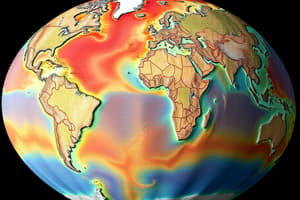Podcast
Questions and Answers
What did Alfred Wegener call the phenomenon of continents moving apart?
What did Alfred Wegener call the phenomenon of continents moving apart?
- Continental drift (correct)
- Seafloor expansion
- Lithospheric shifting
- Oceanic spreading
What did Wegener use to support his hypothesis of continental drift?
What did Wegener use to support his hypothesis of continental drift?
- Correlation of ocean currents
- Evidence of volcanic eruptions
- Matching mountain ranges and coal fields (correct)
- Similar soil composition
What is the driving force behind the motion of tectonic plates according to the theory of plate tectonics?
What is the driving force behind the motion of tectonic plates according to the theory of plate tectonics?
- Solar radiation pressure
- Forces in the mantle (correct)
- Gravitational pull from the moon
- Magnetic fields from the core
What geological feature is formed through hot-spot activity?
What geological feature is formed through hot-spot activity?
Where do most earthquakes occur?
Where do most earthquakes occur?
What is a mantle plume?
What is a mantle plume?
What creates stress from plate movements?
What creates stress from plate movements?
What geological evidence supports the theory of seafloor spreading?
What geological evidence supports the theory of seafloor spreading?
How are divergent boundaries primarily characterized on land?
How are divergent boundaries primarily characterized on land?
What is the driving force behind the motion of tectonic plates at convergent boundaries?
What is the driving force behind the motion of tectonic plates at convergent boundaries?
What did Wegener propose, and who later supported it?
What did Wegener propose, and who later supported it?
What geological features are associated with divergent boundaries?
What geological features are associated with divergent boundaries?
What causes earthquakes like the San Andreas Fault?
What causes earthquakes like the San Andreas Fault?
Flashcards
Continental drift
Continental drift
The movement of continents over time
Evidence for continental drift
Evidence for continental drift
Matching mountain ranges and coal fields across different continents
Driving force of plate tectonics
Driving force of plate tectonics
The force within Earth's mantle that drives the movement of tectonic plates
Hotspot activity
Hotspot activity
Signup and view all the flashcards
Earthquake zones
Earthquake zones
Signup and view all the flashcards
Mantle plume
Mantle plume
Signup and view all the flashcards
Tectonic stress
Tectonic stress
Signup and view all the flashcards
Evidence for seafloor spreading
Evidence for seafloor spreading
Signup and view all the flashcards
Divergent boundary characteristics
Divergent boundary characteristics
Signup and view all the flashcards
Slab pull
Slab pull
Signup and view all the flashcards
Wegener and Hess
Wegener and Hess
Signup and view all the flashcards
Features associated with divergent boundaries
Features associated with divergent boundaries
Signup and view all the flashcards
San Andreas Fault
San Andreas Fault
Signup and view all the flashcards
Study Notes
Understanding Tectonic Plate Movement
- Lystrosaurus fossils found in Africa and Antarctica, suggesting the continents were once connected
- Wegener proposed continental drift but failed to convince scientists; Hess later supported it
- Seafloor spreading explained by molten material intruding at mid-ocean ridges
- Eruptions, magnetic stripes, and rock ages support seafloor spreading
- Earth's poles have reversed multiple times, recorded in seafloor rocks
- Plate movement explained by mantle convection, ridge push, and slab pull
- Plates move in three ways: divergent, convergent, or transform boundaries
- Divergent boundaries occur along mid-ocean ridges and on land as rift valleys
- Convergent boundaries result in continent-continent collisions, mountain formation
- Transform boundaries, like the San Andreas Fault, cause earthquakes
- Plate movement causes volcanic activity, earthquakes, mountain building
- All continents were once part of Pangaea, which slowly broke apart to form present continents
Studying That Suits You
Use AI to generate personalized quizzes and flashcards to suit your learning preferences.




